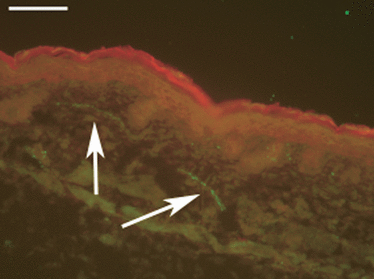The reinnervation and revascularisation pattern of scarless murine fetal wounds
- PMID: 21434911
- PMCID: PMC3125900
- DOI: 10.1111/j.1469-7580.2011.01366.x
The reinnervation and revascularisation pattern of scarless murine fetal wounds
Abstract
Fetal wounds can heal without scarring. There is evidence that the sensory nervous system plays a role in mediating inflammation and healing, and that the reinnervation pattern of adult wounds differs from that of unwounded skin. Ectoderm is required for development of the cutaneous nerve plexus in early gestation. It was hypothesised that scarless fetal wounds might completely regenerate their neural and vascular architecture. Wounds were made on mouse fetuses at embryonic day 16.5 of a 19.5-day gestation, which healed without visible scars. Immunohistochemical analysis of wound sites was performed to assess reinnervation, using antibodies to the pan neuronal marker PGP9.5 as well as to the neuropeptides calcitonin gene-related peptide (CGRP) and substance P (SP). Staining for the endothelial marker von Willebrand factor (VWF) allowed comparison of reinnervation and revascularisation. Wounds were harvested at timepoints from day 1 after wounding to postnatal day 6. Quantification of wound reinnervation and revascularisation was performed for timepoints up to 6 days post-wounding. Hypervascularisation of the wounds occurred within 24 h, and blood vessel density within the wounds remained significantly elevated until postnatal day 2 (4 days post- wounding), after which VWF immunoreactivity was similar between wound and control groups. Wound nerve density returned to a level similar to that of unwounded skin within 48 h of wounding, and PGP9.5 immunoreactive nerve fibre density remained similar to control skin thereafter. CGRP and SP immunoreactivity followed a similar pattern to that of PGP9.5, although wound levels did not return to those of control skin until postnatal day 1. Scarless fetal wounds appeared to regenerate their nerve and blood vessel microanatomy perfectly after a period of hypervascularisation.
© 2011 The Authors. Journal of Anatomy © 2011 Anatomical Society of Great Britain and Ireland.
Figures








References
-
- Aldskogius H, Hermanson A, Jonsson CE. Reinnervation of experimental superficial wounds in rats. Plast Reconstr Surg. 1987;79:595–599. - PubMed
-
- Altun V, Hakvoort TE, van Zuijlen PP, et al. Nerve outgrowth and neuropeptide expression during the remodeling of human burn wound scars. A 7-month follow-up study of 22 patients. Burns. 2001;27:717–722. - PubMed
-
- Artuc M, Hermes B, Steckelings UM, et al. Mast cells and their mediators in cutaneous wound healing – active participants or innocent bystanders? Exp Dermatol. 1999;8:1–16. - PubMed
-
- Buckley G, Metcalfe AD, Ferguson MWJ. Peripheral nerve regeneration in the MRL/MpJ ear wound model. J Anat. 2011;218:163–172. doi: 10.1111/j.1469-7580.2010.01313.x. - DOI - PMC - PubMed
-
- Bush J, Duncan J, Bond J, et al. Scar-improving efficacy of Avotermin administered into the wound margins of skin incisions as evaluated by a randomised, double-blind, placebo-controlled, Phase II clinical trial. Plast Reconstr Surg. 2010;126:1604–1615. - PubMed
Publication types
MeSH terms
Substances
LinkOut - more resources
Full Text Sources
Research Materials
Miscellaneous

